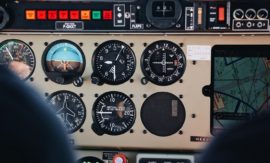Intended learning outcomes: Describe the selection of the mode of transport. Explain the transport chain from supplier to receiver and various kinds of organizing transshipment points.
Following picking of the goods to be shipped and packing, the next step is planning the transport of the goods to the receiver. Transport itself is often outsourced to a third-party logistics provider. The specific distribution network structure resulting from storage locations planning determines the distances of the routes and the choice of means of transport.
Transport planning and scheduling involve finding solutions in three problem areas: selection of the mode of transport, shipping route planning, and loading space optimization.
Fair and Williams (in [Ross15]) define a number of objectives that should be achieved through transport planning and scheduling. The most important objectives are most continuous flow of goods through the distribution network; optimal, load-specific selection of the mode of transport; minimization of number of vehicles; standardization of loading aids (pallets, containers); and maximization of capacity utilization (capital, equipment, personnel).
Figure 15.4.3.1 shows interactions and mutual influences among the three main transport planning and scheduling tasks.
Fig. 15.4.3.1 Problems of transport planning and scheduling. (Following [Stic04])
The selection of the mode of transport is largely determined by the type of load. Bulk goods loads, that is, unpackaged substances in the form of solids, liquids, or gases, entail other requirements as to the mode of transport than loads that are made up of discrete standard loads like containers, packages, pallets, or sea containers. The specific nature of the goods to be shipped stipulates further requirements: The goods may be perishable, combustible, explosive, sensitive, or prone to shrinkage.
Possible modes of transport away from the company are road motor vehicles, railways, ships, and aircraft. The transport chain may integrate both company-owned vehicles (such as trucks) and public modes of transport. For bulk goods, pipeline systems are possible. Bowersox (in [Ross15]) outlines six criteria that influence the decision on mode of transport: speed, “completeness” (using the least possible number of different modes within one distribution channel), dependability, capability (not all goods can be transported via all modes of transport), transport frequency, and costs.
For the delivery of a transportation order, a combination of transport modes can form a transport chain. A distinction is made among direct course (no interruption from supplier to receiver), “pre” course (from supplier to transshipment point), “post” course (from transshipment point to receiver), and main course (from transshipment point to transshipment point). The advantages of individual modes of transport can be utilized for the various legs of the transport. Because of their flexibility, trucks are often used for “pre” and “post” course, whereas for the main course over great distances, the choice falls on air or water transport. Figure 15.4.3.2 shows some examples of transport chains.
Fig. 15.4.3.2 Transport chain from supplier to receiver.
When changing the means of transportation, there is the problem of getting the goods from one modality to another. While the transfer of the goods can be simplified through the use of standardized loading aids like containers or pallets, transferring goods entails special handling equipment (gantry crane, winch, lifting platform, chute, and so on), time and personnel, and associated costs. The following concepts are gaining in importance:
- Cross-docking, or direct loading, is the concept of load building on the incoming vehicle so that the packaged goods can be easily carried at the transshipment point to the outgoing vehicle, without being stored in temporary inventory (cf. [ASCM22]).
- The objective of combined transport is to transport goods using two modes of transport in combination, such as rail/road, in the best way possible so as to utilize the advantages of each. This is achieved through the use of intermodal transport units (container, swap body, or semi-trailer/goods road motor vehicle).
- Trailer on flat car [TOFC] transport is a synonym for road transport that is in part moved by rail. Semitrailers or entire road trains (drawbar-trailer combinations) are loaded onto trains. The major part of the journey is by rail; the final leg for delivery to the customer is carried out by road.
Continuation in next subsection (15.4.3b).
Course section 15.4: Subsections and their intended learning outcomes

15.4 Distribution Control
Intended learning outcomes: Explain order picking, packaging, load building, and transportation to receiver.

15.4.1 Order Picking
Intended learning outcomes: Explain discrete order picking and batch picking. Describe sequential picking and zone picking. Differentiate between decentralized goods preparation and centralized goods preparation.

15.4.2 Packaging
Intended learning outcomes: Present a conceptual framework to handle the diverse functions and requirements of packaging.

15.4.2b Load Building
Intended learning outcomes: Explain load building. Identify the levels of aggregation in load building.

15.4.3 Transportation to Receiver
Intended learning outcomes: Describe the selection of the mode of transport. Explain the transport chain from supplier to receiver and various kinds of organizing transshipment points.

15.4.3b Transport Routing and Scheduling
Intended learning outcomes: Present routing and scheduling and the optimization of loading space.
